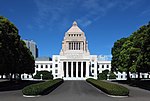House of Councillors (Japan)

The House of Councillors (参議院, Sangiin) is the upper house of the National Diet of Japan. The House of Representatives is the lower house. The House of Councillors is the successor to the pre-war House of Peers. If the two houses disagree on matters of the budget, treaties, or designation of the prime minister, the House of Representatives can insist on its decision. In other decisions, the House of Representatives can override a vote of the House of Councillors only by a two-thirds majority of members present. The House of Councillors has 245 members who each serve six-year terms, two years longer than those of the House of Representatives. Councillors must be at least 30 years old, compared with 25 years old in the House of Representatives. The House of Councillors cannot be dissolved, and terms are staggered so that only half of its membership is up for election every three years. Of the 121 members subject to election each time, 73 are elected from 45 districts by single non-transferable vote (SNTV) and 48 are elected from a nationwide list by proportional representation (PR) with open lists.
Excerpt from the Wikipedia article House of Councillors (Japan) (License: CC BY-SA 3.0, Authors, Images).House of Councillors (Japan)
National Route 246, Chiyoda
Geographical coordinates (GPS) Address Nearby Places Show on map
Geographical coordinates (GPS)
| Latitude | Longitude |
|---|---|
| N 35.676527777778 ° | E 139.74458333333 ° |
Address
国会議事堂
National Route 246 1
100-0014 Chiyoda
Japan
Open on Google Maps








